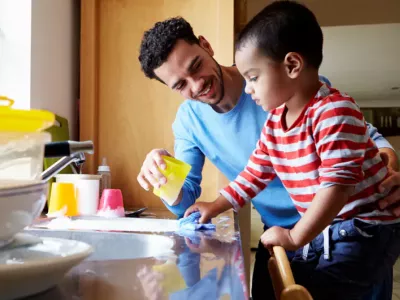How To Handle Tantrums: Try These Positive Parenting Tips

Let’s face it, knowing how to handle tantrums can be a struggle, and for good reason.
They can be explosive and unpredictable. And if you’re tired or stressed, they can feel all-the-more difficult to deal with.
If you’re like many parents and caregivers, it’s hard to stay calm when a temper tantrum happens.
It can help to remember tantrums are a normal part of young children’s development. They can be as short as 20 seconds or go on and on, and are common in the toddler years.
So how can you handle tantrums with more confidence and patience?
Let’s look at what tantrums are, why they happen, and what you can do to manage them.
What’s a tantrum?
Temper tantrums come in all forms.
They can include crying (without being physically hurt), screaming, stomping, throwing objects, rolling around on the floor, or holding their breath.
Sometimes, tantrums seem to come out of nowhere, while other times, you might notice the signs a tantrum is brewing.
Why do toddlers have temper tantrums?
Everyone gets frustrated or angry – it’s part of being human.
For young children, especially toddlers, tantrums are a common way of expressing their strong emotions.
As they grow, the emotional centre of their brain is developing, which means they’re learning how to control impulses, communicate their needs, and express themselves.
They can often get upset when:
- They’re told “no”
- Things don't go the way they want or expect
- They're unable to manage difficult tasks
- They don't yet have the words to say what they want or need
- They’re hungry, tired, sick, stressed or overstimulated
- Sometimes, there’s no obvious reason for a tantrum
So, the next time you find yourself dealing with a tantrum, try to remember they're not trying to deliberately annoy you.
Children are learning important skills such as problem-solving, following instructions, waiting, getting along with others, and expressing themselves with words.
They’re also learning how to manage uncomfortable emotions.
What to do when a child has a tantrum
Stay calm
It’s not always easy to stay calm when you’re dealing with a tantrum. But it helps.
Why? If we get loud or angry in response to a tantrum, we add an intense reaction on top of their big emotions.
Like adding fuel to a fire, this can make the tantrum get bigger and last longer.
During times of strong emotions, try taking a few deep breaths and pausing before you respond. When things feel out of control, your main focus can be to keep in check of your own emotions. This can deescalate a tantrum.
Each time you stay calm, it helps children to learn about handling strong emotions from your positive example.
Stick to your decisions
Imagine a parent and child are out shopping and everything is going smoothly until the child sees a small toy they really want.
The parent calmly says "no" and asks the child to put it back. The child refuses, and starts crying, stomping, then screaming. Eventually, the parent gives in and buys the toy just to calm things down.
Dealing with a tantrum without giving into them can be tough. However, giving in can be teaching your child a tantrum is an effective way to get what they want. And if tantrums work, they're likely to happen again!
Before saying "yes" or "no" to your child's request, take a moment to consider if it's reasonable. Once you make up your mind, try to stick to it.
Of course, it's important to acknowledge their feelings and explain why you’re saying no in a caring way – “I know you're upset because you wanted the toy. Still, we can't buy everything we want.”
Try to keep this brief. Too much attention, explaining, reasoning or soothing can have the reverse effect. They might miss an opportunity to learn to settle themselves down.
Avoid teaching and reasoning mid-tantrum
When a child is upset, angry or frustrated, it's not the best time to teach or reason with them.
Instead, it's better to wait until everyone is feeling calmer.
Have a chat with your child about their emotions and how they can react next time.
For example, "I know it was tough leaving the playground when we had so much fun. Next time, let's try to take some deep breaths, shake out those sad feelings, and remember we'll come back again."
How to stop tantrums
Help your child recognize and express their feelings
Behind every temper tantrum is usually a big feeling.
Talk to your child about feelings and teach them the names of different emotions – “You look sad. Are you sad because your toy broke?”
Talk about how everyone has uncomfortable emotions sometimes, like anger, fear, sadness and disappointment.
Let them know that it's okay to feel frustrated when they can't have something they want. Talk to them about how you can react – “It's tough when we can't have what we want. Let's take a deep breath and blow that frustration away!”
Show them ways to stay calm when they’re feeling angry or upset, like taking some slow, deep breaths or changing activities.
Let them know that even when they're upset or angry, it's not okay to shout or hurt anyone.
When we help them understand and cope with these emotions, tantrums can become less frequent and less intense.
It’s best to have these conversations when things are going well, not when there’s a problem.
Have a plan
Planning ahead for possible tantrums can help you feel calmer and more prepared, like having an umbrella handy on a rainy day. Here are some tips to keep in mind.
- Store away items you don't want your child to touch so you can avoid constantly saying "No" and "Don't touch".
- Have a few simple, consistent and achievable rules. This helps children understand what's expected of them.
- Try to keep their usual routine for sleep and meal times.
- When you're out and about, and you know your child may get bored and disruptive, have some activities on hand to keep them entertained. Be mindful of relying too much on digital devices. Recent research has found frequently using digital devices to distract kids from tantrums was associated with more difficulty managing emotions.1
- If you notice a tantrum brewing, sometimes distraction is all that’s needed. Try a change of scenery, pointing out something interesting, or switching to a different activity.
- If you know certain situations tend to trigger a tantrum, try to think ahead. For example, if they tend to get grumpy when they’re tired or hungry, have some snacks or a quiet activity ready.
It’s also helpful to talk to them throughout the day about what you're doing and what will happen next.
For example, imagine you're at the park and it's time to go home. Instead of saying "let's go", you could say "in a few minutes, we're going to start packing up and getting ready to leave."
Then, when it is time to go, remind them. For example, "okay, it's time to say goodbye to the park and get ready to go home."
This can help children feel more in control and less surprised by changes.
Encourage behaviour you like
Sometimes, we focus on correcting behaviour and forget to appreciate and encourage the behaviour we want to see.
The next time you see your child being helpful, sharing, or listening (or doing anything else you appreciate), give them specific praise.
Paying attention to and praising the good things they do increases the chances of kids repeating that behaviour.
Toddler tantrums: when to worry
Toddler tantrums are a normal and expected part of a young child's development. They can start around 12 months of age and are common in 2-year-olds.
Studies have also found children between 3-4 years old tend to have an average of one tantrum a day.2
This is also the age where tantrums start to become less frequent – so hang in there!
Every child is unique, and some may have more tantrums than others.
With guidance and support, tantrums can become less common as children learn to express their emotions and wants, and solve problems in other ways.
If you're finding it tough to deal with frequent or intense tantrums, or if you are worried about aggression, reach out for support. Talk to your partner, family or friends, or seek advice from your doctor or health professional.
Things to keep in mind:
- Despite your best efforts, sometimes tantrums will still happen. Remember: the tantrum isn’t personal, it’s part of their development. Try to focus on staying calm and guiding their behaviour.
- Building a positive relationship with your child can improve their emotional regulation skills.
- Take care of yourself too. Self-care can make all the difference in how you handle the ups and downs of parenting.
- With practice and patience, you can guide their behaviour and help your child to learn some lifelong skills.
References
1 Radesky et al. (2023). Longitudinal associations between use of mobile devices for calming and emotional reactivity and executive functioning in children aged 3 to 5 years. JAMA Pediatr, 177(1), 62.
2 Hoyniak et al. (2023). Developmental pathways from preschool temper tantrums to later psychopathology. Dev Psychopathol, 35(4), 1643.

